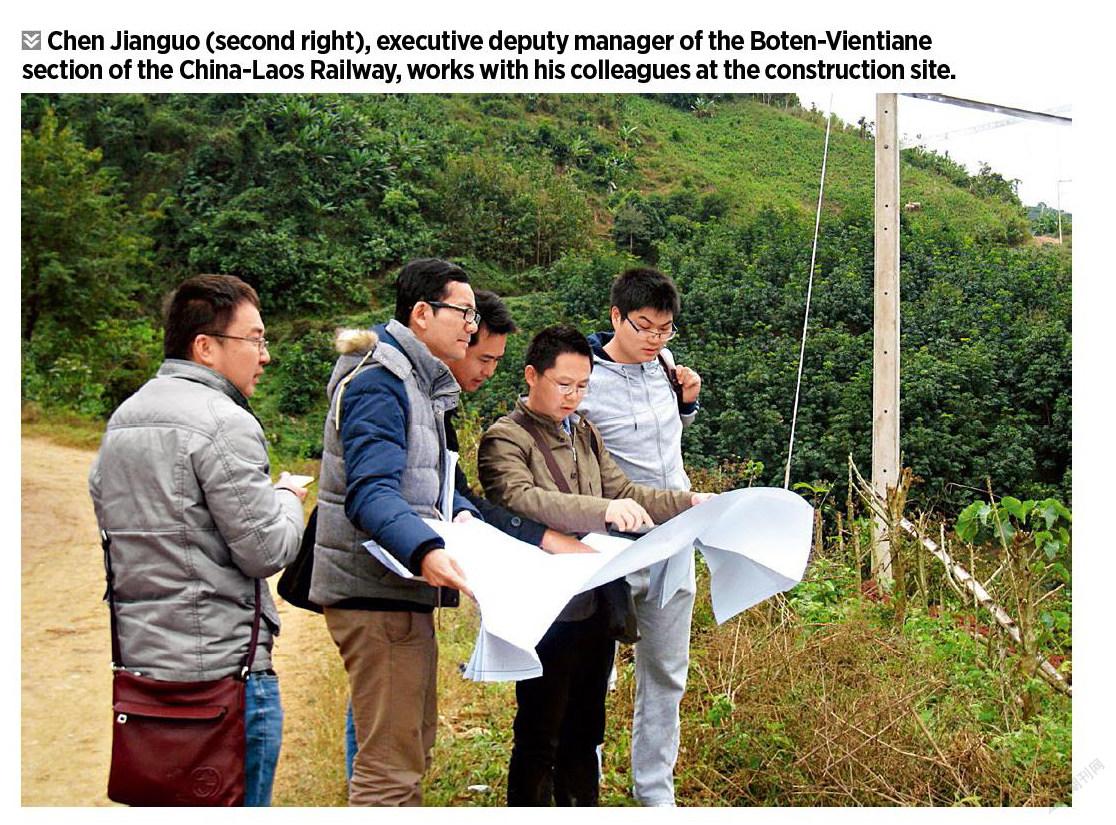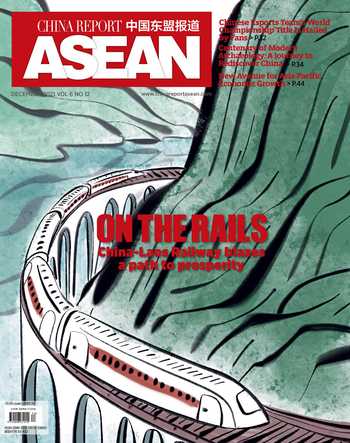FACES OF THE CHINA-LAOS RAILWAY



The China-Laos Railway has become a major pillar of Laos dream to transform from a landlocked country into a land-linked hub. Thanks to perseverance and dedication from railway designers and workers, this dream is coming true.
Trailblazers
Chen Jianguo of China Railway Eryuan Engineering Group Co. Ltd. is executive deputy manager of the Boten-Vientiane section of the ChinaLaos Railway. When planning for the China-Laos Railway started in 2010, he received a memo from his company: “Building a railway is a demanding task, and there is a shortage of hands. Capable professionals are needed to reinforce the workforce.” Chen accepted the assignment to work in Laos without hesitation.
The Chinese and Lao governmentssigned a memorandum on cooperation on building a railway between the twocountries in April 2010, but the projectwas not approved by the Lao congressuntil December 2015. During the fiveand halfyears in between, Chen andother technicians from his companyconducted extensive research onissues of concern identified by theLao government including cargo andpassenger volumes of rail transportbetween the two countries, technicalstandards, estimated investment,implementation mode, and potentialrisk. As a representative of thedesigners, Chen delivered reports andconducted exchanges with relevantcorporations, government agencies,and financial institutions withprofessionalism and competence. Hisefforts contributed greatly to the launch of the project.
When working in Laos, Chen and his colleagues had to grapple with the hotand humid weather, underdevelopedtransportation, and densely woodedterrains inhabited by land leeches,snakes, and large animals. Surveyingsuch environments was tough anddangerous. Many of the places the team needed to study were not accessibleby paved roads, so the members hadto walk through shrubs or forests toreach them. Poisonous snakes were aconstant threat, but land leeches werejust as dangerous because they canpierce through thick clothes to reachhuman flesh. On such excursions, Chen always walked ahead of his colleagueswearing a wide-brim hat, a long-sleevedshirt, and ankle-tied pants and carrying equipment, water, food, and snakerepellent. It was normal to leave thecampsite at dawn and return at dusk. “As designers, we are obliged to delivergood service for the project and itsbuilders,”Chen said.
Challenges brought by the tropicalweather and geography also acutelyaffected the railway builders. Lu Haiyong is project manager for four stations onthe Yuxi-Mohan section of the China-Laos Railway. Construction of thesestations in Puer and Xishuangbannain Chinas Yunnan Province startedduring the regions rainy season. Largeengineering vehicles could hardlynavigate the slushy ground whichbecame flaky when dry. It also madedrilling and digging perpetually tricky.
After repeated field studies, Hu andhis team engineered a strategy to makethe most of sunny and drizzly days and mitigate the impact of rains througheffective drainage. They designeddrainage routes and measures, andset up posts to monitor the rainwaterdiverting process at the constructionsite around the clock. Gravel and steelplates were brought in as makeshiftroad paving materials to enable heavyvehicles to operate on rainy days.“When it rained, the ground got covered inmud as thick as syrup, and when thesky cleared up, it quickly became dusty,” described Lu.“After one day on theconstruction site, our young engineerswere either soaked in mud or coveredwith dust.”
Under such harsh conditions, Ludrew strength from the support of thelocal people. Many residents, students, and government employees fromthe city came to see the completionof the Puer station and took photos.“Everyone I talked to was interested inthe project and we frequently walkedout to check on its progress afterdinner,”said an elderly man surnamed Wang.“Even though we couldnt enterthe construction site, we witnessed thestation rise from ground zero, and justthinking about a train station so close to our homes is exciting.”
Lu often reminded his colleaguesthat the four stations they were building would be the largest and busiest on the China-Laos Railway, and encouragedthem to deliver their best possible work. He said that failing the government and the public was not an option regardless of whatever difficulties emerged.
After the China-Laos Railway brokeground in 2016, the frontline managers could hardly take a few days off, evenduring Chinese New Year. With the line now completed and open to traffic,Chen and Lu hope to again spend theupcoming Chinese New Year at homewith their families.
Troubleshooters
The 1,000+ kilometers betweenKunming and Vientiane, the terminusesof the China-Laos Railway, is dottedwith treacherous terrain. As deputychief of the rail laying team of the Yuxi-Mohan Railway, Feng Bin became amaster at solving problems associatedwith such terrain.
The complex geological conditionspushed Feng to seek the latesttechnologies concerning rail layingmachines and ballast/ballastless tracks,and he became the first in his team tomaster them so he could guide othertechnicians in his spare time. Underhis leadership, the team employednew technologies and equipment toimprove the precision and efficiency ofrail construction.
Feng impressed his colleagueswith his passion and dedication to thework. He was an insatiable learner.He was always the first to arrive at theconstruction site and the last to leave.He often carried a pen and a notebookaround to record everything he learnedand observed during the day. Henever hesitated to consult others with questions and attentively watched senior engineers solve technical problems to learn from them. These efforts paid off, and he soon became a master of rail laying himself.
The Yuanjiang Railway Bridge on the Yuxi-Mohan Railway is the highest steel truss bridge in the world, with the tallest railway piers ever built. Its construction was overseen by a group of technicians with an average age below 30. Zhou Jiawu, 28, was chief engineer.
Zhou joined the project in 2016 and spent the next five years on the Yuanjiang Railway Bridge, first as a technical supervisor and later as chief engineer.
The steel-concrete bridges doublecolumn piers are connected by a scissor-shaped steel structure, the first of its kind in China. This structure is fastened to the piers with PBL shear connectors which require highly challenging installation and welding but are critical for the safety of the bridge. In his capacity as a technical supervisor, Zhou closely monitored the process on the site every day.
After Zhou finished a day at the construction site, he would continue paperwork in his office late into the night. His colleagues often noticed the light still on in his office in the early hours of the morning. “In December 2020, technicians were needed to help installing rail marker posts, so Mr. Zhou and I took on the task,” recalled Zhu Tao, a fellow technical supervisor. “We worked from morning to night for three days straight, eating instant noodles and lugging surveying equipment around. To get the most accurate data, he would personally venture into dangerous spots all the time.”
Looking back on their five years working on the China-Laos Railway, both Feng and Zhou expressed pride for the contributions they were able to make and for the opportunity to witness completion of this rail line.
Master Researchers
The success of a mega engineering project requires not only hard work but also technical excellence. YinDaxiang is the deputy chief engineerand lab director of the China-LaosRailway. After rich expertise fromprevious assignments includingthe Nanning-Kunming, Neijiang-Kunming, Chongqing-Wanzhou, andHaolebaoji-Jian railways and theJinping Hydropower Station, he headed operation of the China-Laos Railwaylaboratory and ensured tests werecarried out smoothly there. His effortswon acclaim from both Chinese andLao partners on the project.
To ensure safe, fast constructionof tunnels, Yin and other members of his lab developed a high-performance, superfine concrete mixture afterrepeated experiments and trials overfive months. It significantly reduced the time needed for primary support andclosed loop control and saved costs. Itwas just one of the many innovationsYin made for the China-Laos Railway.His team secured the railways positionas an exemplary project of top qualityunder the Belt and Road Initiative.
Yin remains humble about hisachievements.“I am an ordinary labmanager,”hesaid.“Theachievementsof the lab are the results of collaboration and hard work from the whole staff. Ibelieve that lab work is critical to bolster the quality of every engineering project. Many research subjects are still waitingfor our work.”
Kong Huarong, a senior technician from the China Railway WuhanElectrification Bureau, is known forhis readiness and ability to tackletough issues. During construction ofthe Yuxi-Mohan section of the China- Laos Railway, he was the go-to person whenever his colleagues encountered any technical problems. And healways found solutions throughconducting field studies, pouring over files, and consulting relevant parties. His rigorous attitude to work and grit in confronting difficulties won himrespect from all sides.
Thanks to the perseverance oftechnicians like Yin and Kong,construction of the China-LaosRailway proceeded as scheduled with safety and quality guaranteed andcosts controlled. Even though theproject is now complete, the research continues. Technicians always havemore to learn and practice to boost the high-quality development of Chinasrailway industry.
Woman Power
“We have only seen trains inpictures,”said a student fromNongping Primary School in thesuburbs of Vientiane.“After the China- Laos Railway is completed, we cantake a train to China and make friendsthere.”MaYurong was deeply touched to hear the childs words.
As deputy chief of the China-Laos Railway command from ChinaRailway Group Limited (CREC), Ma was involved in many public awarenessactivities in Laos during construction of the rail line. The efforts includedstorytelling sessions for childrenabout Chinese history and railwaysand youth exchange in partnershipwith the Confucius Institute atSouphanouvong University.
Students from Nongping PrimarySchool wrote a letter to PresidentXi Jinping before the Second Beltand Road Forum for InternationalCooperation in 2019. On April 29 ofthat year, President Xi sent them awritten reply through the ChineseEmbassy in Laos, causing excitement among teachers and students.PrincipalBounmy told Ma thatthe schools connection with Chinastarted with construction of theChina-Laos Railway under the BRIand referred to the railway as a pathof DokChampa, the national flowerof Laos. Ma never expected the railline to deepen friendship and cultural connectivity between the two peoples as much as it did, in addition to theeconomic benefits.
With assistance from CREC, the primary school received ping pongtables and built a new playground. “The years of construction on theChina-Laos Railway helped morechildren learn about China,”a teacher at the school told Ma.“China hasbecome part of their dreams, andmany of them now hope to study inChina in the future.”
Mas responsibilities transcended publicity activities. As deputy chiefof the project command, she oversaw tasks big and small ranging fromcoordination of construction tobirthday gifts for employees. She was addressed as“BigSister”by her staff.
Pan Longzhu, a member ofproject command, described Ma as like family. During the four yearsthey worked in Laos, she organized decorating rooms, preparing meals, and staging performances for theChinese New Year to maintainemployeesspirits while they were stuck so far from home.
When the railway was completedat the end of 2021, Ma had been onthe job for 11 years. Like many of hercolleagues, she now considers Laos asecond home. During the project, sheand most of her colleagues spent more time at the construction site than attheir homes in China. When askedabout their feelings about the projectending, the unanimous responses were in the realm of“proud”and“honored.”

